| Article ID | Journal | Published Year | Pages | File Type |
|---|---|---|---|---|
| 5728756 | Transplantation Proceedings | 2017 | 4 Pages |
â¢Concurrent hepatic tuberculosis and graft-versus-host disease is not uncommon but challenging in allogeneic hematopoietic stem cell transplant recipients.â¢Recognition of the dual pathology in the biopsy aids proper treatment.
BackgroundInfection and graft-versus-host disease (GVHD) are among the most common complications after hematopoietic stem cell transplantation (HSCT). With well-known risk factors including allogeneic HSCT and GVHD, tuberculosis (TB) has a higher incidence and shorter survival rate in HSCT recipients than in the general population.Case ReportA 55-year-old Indonesian female with a history of latent TB was found to have acute myeloid leukemia 3 months after allogeneic HSCT. She presented with fever, abdominal pain, and predominant cholestatic-type liver function tests derangement. Computed tomography scans showed a relatively unremarkable liver. Liver biopsy specimens revealed multiple necrotizing granulomas with numerous acid-fast bacilli shown using Ziehl-Neelsen histochemical stain. No fungal organisms are detected by Grocott's methenamine silver and periodic acid-Schiff stains. There was also mild portal hepatitis with prominent bile duct injury and scattered apoptotic bodies, compatible with GVHD. In addition, the patient was also discovered to have cutaneous and intestinal TB as well as cutaneous and colonic GVHD during investigation. She was started on anti-TB treatment and adjusted immunosuppression scheme accordingly. Unfortunately, our patient died of spontaneous intracranial haemorrhage approximately 2 months after the diagnosis of post-transplantation TB and GVHD.ConclusionWe report a case of concurrent hepatic TB and GVHD in an allogeneic HSCT recipient. Recognition of the dual pathology in the biopsy results aids proper treatment.
